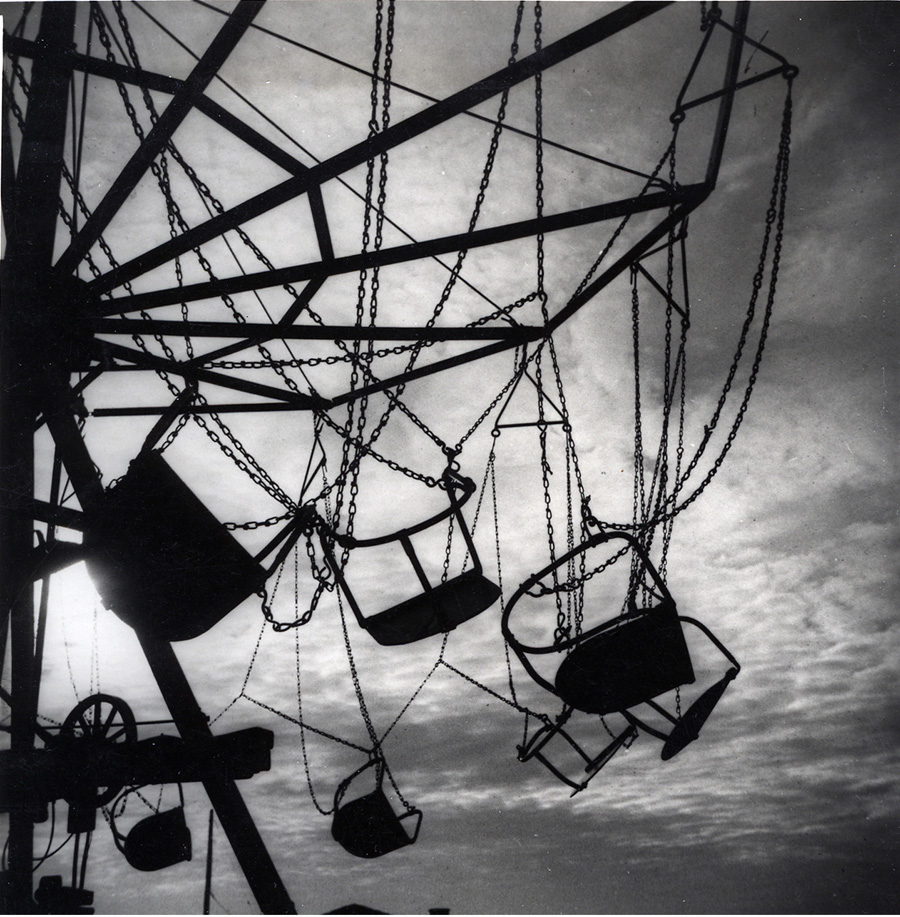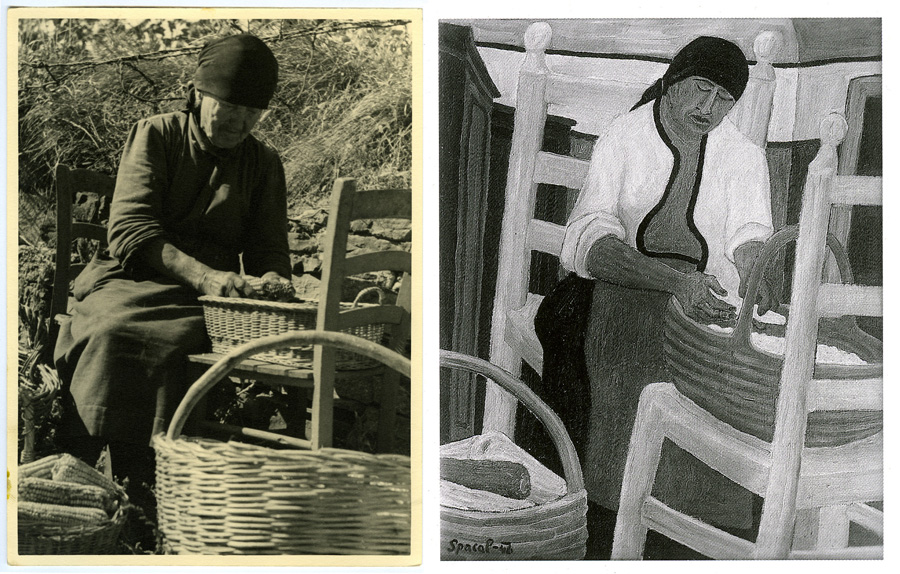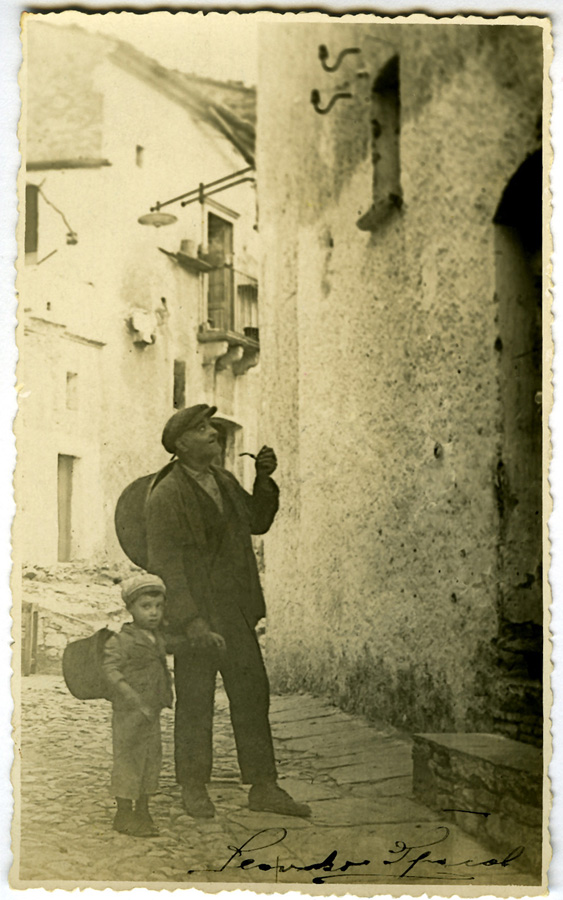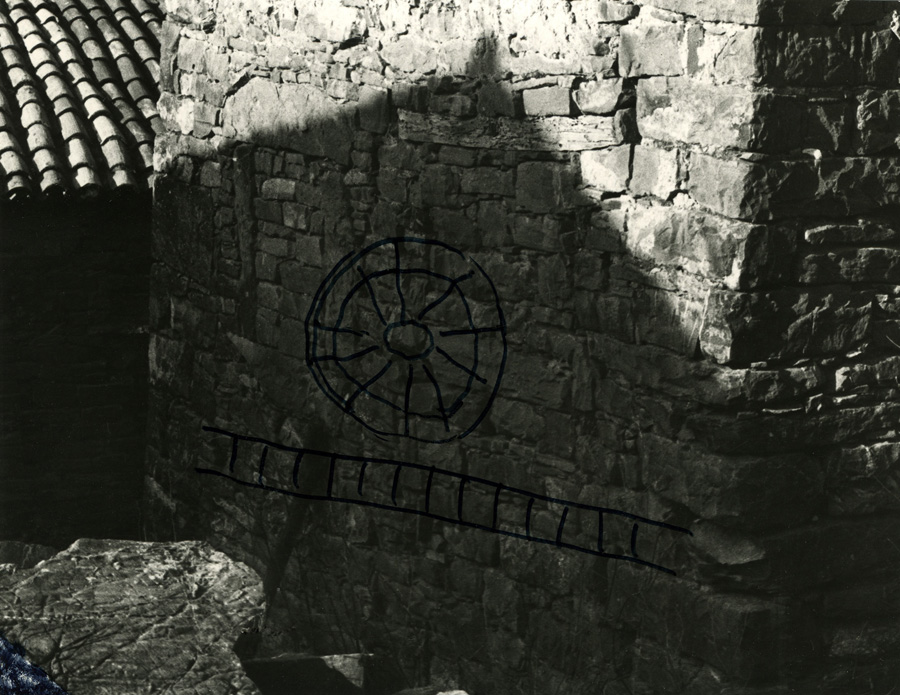The Painter's Eye and The Camera
 Merry-Go-Round, c. 1955, gelatin-silver print
Merry-Go-Round, c. 1955, gelatin-silver print
28 June - 12 August 2007
International Centre of Graphic Arts (MGLC), Grad Tivoli, Pod turnom 3, Ljubljana
Spacal's Photographic Conquest of Reality
Exhibition curator: Lara Štrumej
Although photography was the first visual medium Lojze Spacal adopted, and kept resorting to throughout his career, his photographic works were until recently virtually unknown. This is largely due to the artist himself; he only mentioned his photographic activities in passing in his earliest interviews, when talking about the time he was exiled to Accettura in southern Italy in the early 1930s. For a while he earned a living as a professional photographer there, recording important events and portraying local people with his old Leica. The photographs he brought with him from his exile evidence that he was a keen observer of village life.
Once Spacal started painting, he only took photographs when prompted by his artistic aspirations. While studying art in Monza, the focus of his interest was the human body; he photographed it from several angles and arranged the prints on a single sheet in a sequence that allowed him to analyze the interdependent positions of the body. Photography was a part of Spacal's thinking about art; all his artistic activities - from drawing, painting to printmaking - revolved around his incessant quest that originated in the dialectic relationship between the artist's interaction with the exterior world and the "laws" of his interior world.
Spacal took photographs spontaneously, while walking on the shore or visiting harbors, saltpans, shipyards in Istria and the Karst, always guided by his artistic imagination. He was particularly fascinated by features that were typical of the Littoral and the Karst, the ones that preoccupied him as a painter and that we are familiar with from his prints and drawings-stone and wooden fences, wooden first-floor outside corridors, hay stacks, reflections on water surface, fishing nets, saltpans, boats, and courtyards. As there is great iconographic, and sometimes also formal, similarity between his photographs and his paintings or prints, it can be assumed that photography played a similar role in his creative process as sketches and study drawings. In his early period there are shots that served as models for his paintings Peasant Woman (1946) and Spinner (1946) and for his prints Covered Terrace in Istria (1950) and Karst Barrier (1950). Later, when the artist started pursuing his own vision of the world in his painting, with no obvious analogies to the exterior world, his photographs served as an instrument of scrutiny and analysis of the basic elements of the Littoral and Karst material reality, and as a source of subject matter for his modernist artistic language.

Peasant Woman, 1945, gelatin-silver print; Peasant Woman, 1946, oil, canvas
Due to the imminent renovation of the Moderna galerija building, the exhibition of Spacal's photographs is being staged at the International Center for Graphic Arts, where our colleagues have kindly let us use part of their exhibition premises. Apart from a few earliest photographs, which Spacal brought with him from his exile, most photographs date from the end of World War II to the early 1970s; in addition to that, the show comprises drawings, two paintings, and a number of graphic prints that reveal that photographs provided him with visual aids in the analysis and transformation of the perceived into graphic prints or paintings.
 Tinker, c. 1932, gelatin-silver print
Tinker, c. 1932, gelatin-silver print
There are ninety-nine photographs on view, quite a lot of them contact prints, and eighteen other works - drawings, graphic prints, paintings and a sketch for the set design of the opera Nozze Istriane (Istrian Wedding). These works are on loan from the International Center of Graphic Arts, the Lojze Spacal Gallery in Štanjel, the Association of Slovene Cultural Societies in Trieste, one graphic print is from the collections of the Museum of Modern Art, and some of the works are the property of the artist's family.
The exhibition will be accompanied by a catalogue in Slovene and English, one of six publications dedicated to the 100th anniversary of Lojze Spacal's birth. Lara Štrumej's text accompanies a wealth of pictorial material: in addition to photographs there are also a number of drawings, graphic prints, and paintings that illustrate the realization presented in the text, i.e., the close interconnection between Spacal's photographs and his works of art.
Exhibition curator: Lara Štrumej
 Stone Wall with Shadow, c. 1965, gelatin-silver print, black felt-tip pen drawing
Stone Wall with Shadow, c. 1965, gelatin-silver print, black felt-tip pen drawing
The catalogue was published with the kind help of the company ISTRABENZ.
Sign up for the MG e-newsletter
Museum of Modern Art
Windischerjeva ulica 2
SI-1000 Ljubljana, Slovenia
Phone
MG+:+386 (0)1 2416 800,
+386 (0)1 2416 834
+MSUM: (0)1 2416 825
Fax: +386 (0)1 2514 120
E-mail: info@mg-lj.si
MG+MSUM
History of the MG
Reconstruction
Opening of the renovated MG
Staff




 MG blog
MG blog
